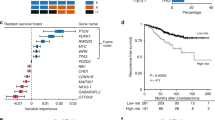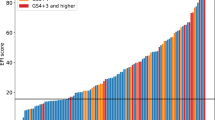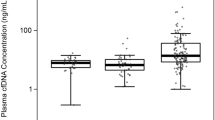Abstract
Several cancers are characterized by large-scale mtDNA deletions. We previously provided evidence that one of these deletions has potential utility in resolving false from true-negative prostate needle biopsies. This study was to assess the clinical value of this deletion in predicting re-biopsy outcomes. We used a quantitative polymerase chain reaction assay to measure the levels of the deletion in individual negative needle biopsies from 101 patients who had a repeat biopsy within a year with known outcomes. Using an empirically established cycle threshold (Ct) cutoff of 31, and the lowest Ct for each patient as diagnostic of prostate cancer, as well as the histopathologic diagnosis on second biopsy, we calculated the clinical performance of the deletion. The Ct cutoff at 31 gave a sensitivity and specificity of 84 and 54%, respectively, with the area under a receiver-operating characteristics curve of 0.749. The negative predictive value was 91%. The assay was able to predict the presence of a missed tumor in 17 out of 20 men a year before diagnosis. This ancillary test appears to identify men who do not require a repeat biopsy with a high degree of certainty. The results suggest that the majority of men with atypical small acinar proliferation have a concurrent missed tumor and therefore require close monitoring for early detection.
This is a preview of subscription content, access via your institution
Access options
Subscribe to this journal
Receive 4 print issues and online access
$259.00 per year
only $64.75 per issue
Buy this article
- Purchase on Springer Link
- Instant access to full article PDF
Prices may be subject to local taxes which are calculated during checkout




Similar content being viewed by others
References
Dhanasekaran SM, Barrette TR, Ghosh D, Shah R, Varambally S, Kurachi K et al. Delineation of prognostic biomarkers in prostate cancer. Nature 2001; 412: 822–826.
Satoh A, Matsumoto K, Nakamura S . Is interval from an initial biopsy a significant predictor of prostate cancer at repeat biopsies? Int J Urol 2006; 13: 224–227.
Eggener SE, Roehl KA, Catalona WJ . Predictors of subsequent prostate cancer in men with a prostate specific antigen of 2.6–4.0 ng/ml and an initially negative biopsy. J Urol 2005; 174: 500–504.
Singh H, Canto EI, Shariat SF, Kadmon D, Miles BJ, Wheeler TM et al. Predictors of prostate cancer after initial negative systematic 12 core biopsy. J Urol 2004; 171: 1850–1854.
Hong YM, Lai FC, Chon CH, McNeal JE, Presti Jr JC . Impact of prior biopsy scheme on pathologic features of cancers detected on repeat biopsies. Urol Oncol 2004; 22: 7–10.
Epstein JI, Herawi M . Prostate needle biopsies containing prostatic intraepithelial neoplasia or atypical foci suspicious for carcinoma: implications for patient care. J Urol 2006; 175 (3 Pt 1): 820–834.
Brausi M, Castagnetti G, Dotti A, De Luca G, Olmi R, Cesinaro AM . Immediate radical prostatectomy in patients with atypical small acinar proliferation. Over treatment? J Urol 2004; 172: 906–908 discussion 908-909.
Fowler Jr FJ, Barry MJ, Walker-Corkery B, Caubet JF, Bates DW, Lee JM et al. The impact of a suspicious prostate biopsy on patients psychological, socio-behavioral, and medical care outcomes. J Gen Intern Med 2006; 21: 715–721.
Maki J, Robinson K, Reguly B, Alexander J, Wittock R, Aguirre A et al. Mitochondrial genome deletion aids in the identification of false- and true-negative prostate needle core biopsy specimens. Am J Clin Pathol 2008; 129: 57–66.
Bostwick DG, Meiers I . Atypical small acinar proliferation in the prostate: clinical significance in 2006. Arch Pathol Lab Med 2006; 130: 952–957.
Dhir R, Vietmeier B, Arlotti J, Acquafondata M, Landsittel D, Masterson R et al. Early identification of individuals with prostate cancer in negative biopsies. J Urol 2004; 171: 1419–1423.
Mehrotra J, Varde S, Wang H, Chiu H, Vargo J, Gray K et al. Quantitative, spatial resolution of the epigenetic field effect in prostate cancer. Prostate 2008; 68: 152–160.
Rizzi F, Belloni L, Crafa P, Lazzaretti M, Remondini D, Ferretti S et al. A novel gene signature for molecular diagnosis of human prostate cancer by RT-qPCR. PLoS ONE 2008; 3: e3617.
Jonathan I, Epstein XJY . Findings of atypical glands suspicious for cancer. In: Prostate Biopsy Interpretation (3rd edn) Lippincott Williams & Wilkins: Philadelphia, pp 177–184.
Dakubo GD, Jakupciak JP, Birch-Machin MA, Parr RL . Clinical implications and utility of field cancerization. Cancer Cell Int 2007; 7: 2.
Haaland CM, Heaphy CM, Butler KS, Fischer EG, Griffith JK, Bisoffi M . Differential gene expression in tumor adjacent histologically normal prostatic tissue indicates field cancerization. Int J Oncol 2009; 35: 537–546.
Theodorescu D, Frierson Jr HF, Sikes RA . Molecular determination of surgical margins using fossa biopsies at radical prostatectomy. J Urol 1999; 161: 1442–1448.
Acknowledgements
This work was supported in part by grants from Industry Canada (FedNor), Sudbury, Canada, and Northern Ontario Heritage Fund Corporations (NHOFC), Sault Ste Marie. We thank the patients and their physician for the samples.
Author information
Authors and Affiliations
Corresponding author
Ethics declarations
Competing interests
The authors Kerry Robinson, Jennifer Creed, Brian Reguly, Cortney Powell, Roy Wittock, Daniel Klein, Andrea Maggrah, Ryan L. Parr and Gabriel D. Dakubo work for and own stocks in Genesis Genomics. Laurence Klotz is a paid consultant with Genesis Genomics.
Rights and permissions
About this article
Cite this article
Robinson, K., Creed, J., Reguly, B. et al. Accurate prediction of repeat prostate biopsy outcomes by a mitochondrial DNA deletion assay. Prostate Cancer Prostatic Dis 13, 126–131 (2010). https://doi.org/10.1038/pcan.2009.64
Received:
Revised:
Accepted:
Published:
Issue Date:
DOI: https://doi.org/10.1038/pcan.2009.64
Keywords
This article is cited by
-
Comparative analysis of camelid mitochondrial genomes
Journal of Genetics (2019)
-
Clinical and Novel Biomarkers in the Management of Prostate Cancer
Current Treatment Options in Oncology (2018)
-
A single mitochondrial DNA deletion accurately detects significant prostate cancer in men in the PSA ‘grey zone’
World Journal of Urology (2018)
-
Mitochondrial mutations drive prostate cancer aggression
Nature Communications (2017)
-
PSA and beyond: alternative prostate cancer biomarkers
Cellular Oncology (2016)



